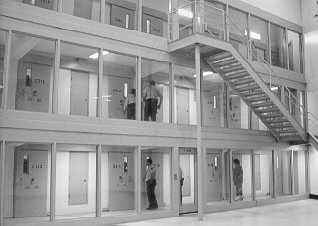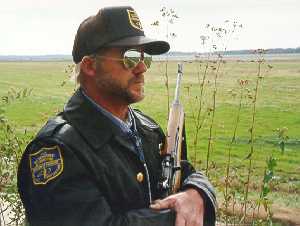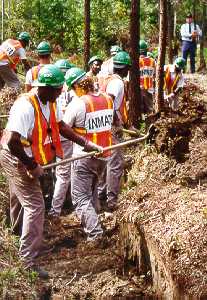
DEPARTMENT OF CORRECTION
James B. Hunt, Jr., Governor
Theodis Beck, Secretary
 |
NORTH CAROLINA DEPARTMENT OF CORRECTION James B. Hunt, Jr., Governor Theodis Beck, Secretary |
| Patty McQuillan, Director of Public Information (919) 733-4926 | |
July 30, 1999
CLEARLY CORRECTIONS
A clarification of inmate work programs
July 1999
Convicted criminals are picked up at the local jails by the Dept. of Correction and taken to one of nine prison receiving centers where they are put through a series of evaluations including medical and mental health screening. Inmate profiles include the offender’s crime, social background, education, job skills, work history, health and criminal record, including prior prison sentences. Based on this information, the offender is assigned to the most appropriate custody classification and prison, with close custody being the most restrictive level and minimum custody the least restrictive.
Of the 31,162 inmates who were in prison at the end of July, 22,218 were assigned to work or education programs. The following is a description of custody levels and the kind of work assignments available to those inmates.
CLOSE CUSTODY
Close is the most restrictive level of custody. Most close custody inmates are housed in single cells. These inmates are closely watched because of they have been convicted of a very serious crime, they are an escape risk, or they have not followed prison rules.
| Inmates in close custody work inside prisons
either in kitchen or janitorial jobs or in Correction Enterprise jobs, usually found
inside prisons such as the license tag or sewing plant. The only place close custody inmates work outside the prison fences is at the 10,000-acre Caledonia/Odom prison farm in Northampton and Halifax counties. In July, 527 close-custody inmates were working in Enterprise jobs. |
 |
 |
Up to 165 inmates at Caledonia and up to 100 inmates at Odom work under heavily armed supervision, planting, weeding and picking row crops. Two armed correctional officers on horseback or mobile platforms, and one unarmed officer in the field, supervise crews no larger than 25 inmates. |
Inmates who are disruptive and who violate prison rules are placed in Maximum Control. At the end of July, 751 inmates were isolated in single cells, spending 23 hours a day confined in the cell with only one hour for exercise outside the cell. There are two levels of maximum control:
High Security Maximum Control, (HCON) - These inmates are not allowed to work due to their unmanageable behavior. They have violated prison rules and are confined in their cells around the clock for punishment. Special cells were designed and built so that the inmate showers inside the cell and exercises in an area immediately outside the cell. He has no contact with other inmates. If he must leave his cell, it is under full restraints accompanied by an officer.
Maximum Control -(MCON) - These inmates are not allowed to work due to their unmanageable behavior. They have violated prison rules and are confined 23 hours a day, showering in a common cellblock area and exercising outside in fenced cubicles. Inmates can converse with other inmates during those times.
MEDIUM CUSTODY
 |
Medium custody inmates is not as restrictive as close
custody, but are still closely watched. Inmates who have shown good behavior in close
custody may be promoted to medium custody. Medium custody inmates work in kitchen or janitorial jobs at the prison, or for Correction Enterprises, or outside the prison fences on heavily guarded road squads. In July, 884 medium-custody inmates were working in Enterprise jobs making such products as soap, paint, inmate uniforms and highway signs, or they were working in prison laundries or the meat packing plant. Another 1,204 medium custody inmates worked outside the fence under armed supervision on road squads, digging ditches, cutting shrubs, and picking up trash. |
MINIMUM CUSTODY
Inmates who have been promoted to minimum custody must be within five years of their release date. There are three levels of minimum custody, with level one being the most restrictive.
Level one minimum custody inmates may work on the grounds and away from a prison unit, as long as an officer is with them. The Community Work Squad inmates are in this category. In July, 1,248 inmates worked in the Community Work Program where groups of up to 10 inmates supervised by an unarmed correctional officer perform manual labor for government agencies. Another 1,283 inmates worked with the Dept. of Transportation doing road work.
Level two inmates may work on the grounds of the prison or away from the unit with supervision. Inmates are also allowed to go out with a person from the community who has volunteered and is certified to work with the inmate.
Level three inmates are in the least restrictive category. These inmates are carefully screened. Inmates may go offsite from the prison for specific programs, jobs, school or other kinds of training. The Work Release Program is in this category. Inmates on work release leave the prison on their own each day to go to a full-salaried job and return to the prison at the end of their work day. The inmates pay for room and board at the prison, restitution, and child support. Any money left over is put in the inmate’s trust fund so when he or she leaves prison, he or she has more than the $40 gate check for a more successful transition back into the working community.
Other Controls for all custody levels:
Intensive Control - (ICON) - These inmates are not allowed to work due to their unmanageable behavior, but this is the not as restrictive as the other two levels. Inmates can exercise in small groups with other inmates in ICON, and they take showers in a common cellblock area. At the end of July, 341 inmates were housed in ICON.
Protective Control - (PCON) - Inmates in this category are housed in an area separate from the regular prison population to protect them from predatory inmates. They do not have job assignments. Inmates in protective control are able to spend time in the day rooms directly outside their cells and mix with other protective custody inmates. At the end of July, 46 inmates were housed in PCON.
Administrative Segregation - When an inmate is accused of committing a rule infraction, he could be placed in administrative segregation pending the outcome of the investigation into the incident. Inmates do not work while in administrative segregation.
Disciplinary Segregation- If a disciplinary committee finds an inmate guilty of an infraction such as disobeying an order, using profane language, assaulting an officer or attempting to escape, he is placed in disciplinary segregation and, depending on the seriousness of the infraction, may be demoted to a higher custody level . Inmates do not work while in disciplinary segregation.
Safekeepers - The court may order county jails to send people who are either too dangerous to be held in their facilities or who have medical problems to be held in a state prison. Safekeepers have not yet been convicted and are awaiting trial. They are not assigned to work. At the end of July, the Department of Correction was housing 203 safekeepers.